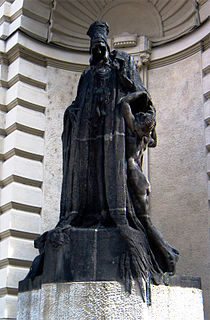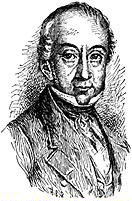
Sefer haYashar is a medieval Hebrew midrash, also known as the Toledot Adam and Divrei haYamim heArukh. The Hebrew title "Sefer haYashar" might be translated as the "Book of the Correct Record" - but it is known in English translation mostly as The Book of Jasher following English tradition. Its author is unknown.

Judah Loew ben Bezalel or Rabbi Loew, alt. Löw, Loewe, Löwe, or Levai – widely known to scholars of Judaism as the Maharal of Prague, or simply The Maharal, the Hebrew acronym of "Moreinu Ha-Rav Loew" – was an important Talmudic scholar, Jewish mystic, and philosopher who, for most of his life, served as a leading rabbi in the cities of Mikulov in Moravia and Prague in Bohemia.

The Tosafot,Tosafos or Tosfot are medieval commentaries on the Talmud. They take the form of critical and explanatory glosses, printed, in almost all Talmud editions, on the outer margin and opposite Rashi's notes.

The Abravanel family, also spelled as Abarbanel, Abrabanel, Avravanel, Barbernell, or Barbanel, literally meaning Ab (father) Rabban (priest) El is one of the oldest and most distinguished Jewish families. It first achieved prominence on the Iberian peninsula during the Middle Ages. Its members claim to trace their origin to the biblical King David. Members of this family lived in Seville, Córdoba, Castile-Leon, and Calatayud. Seville is where its most prominent representative, Don Judah Abravanel, once dwelt.
Mario Castelnuovo-Tedesco was an Italian composer, pianist and writer. He was known as one of the foremost guitar composers in the twentieth century with almost one hundred compositions for that instrument. In 1939 he immigrated to the United States and became a film composer for Metro-Goldwyn-Mayer for some 200 Hollywood movies for the next fifteen years. He also wrote concertos for Jascha Heifetz and Gregor Piatigorsky.
Isaac ben Moses of Vienna, also called Isaac Or Zarua or the Riaz, was among the greatest rabbis of the Middle Ages. He was probably born in Bohemia and lived between 1200 and 1270. He attained his fame in Vienna and his major work, the halachic guide known as the Or Zarua, was very popular among Ashkenazic Jewry. He was a member of the Chassidei Ashkenaz and studied under many scholars, including the Ra'avyah, Rabbi Yehudah HaChasid, the Sar mi'Kutzi and Rabbi Elazar Rokeach. He was among the teachers of Rabbi Meir of Rothenburg.

Josippon is a chronicle of Jewish history from Adam to the age of Titus. It is named after its supposed author, Josephus Flavius, though it was actually composed in the 10th century in south Italy. The Ethiopic version of Josippon is recognized as canonical by the Ethiopian Orthodox Church.
Abraham ben Isaac of Narbonne was a Provençal rabbi, also known as Raavad II, and author of the halachic work Ha-Eshkol.
Baruch ben Isaac, called usually from Worms or from France (Tzarfat) was born approx. in 1140 and deceased in 1212 in Eretz Israel where he went in 1208 together with his friend Samson ben Abraham of Sens. He is not to be identified with another Baruch ben Isaac, a Tosafist and codifier who was born at Worms, but lived at Regensburg,.
Isaiah di Trani ben Mali , better known as the RID, was a prominent Italian Talmudist.
Samuel ben Isaac Ha-Sardi was a Spanish rabbi who flourished in the first half of the 13th century. In his youth he attended the school of Rabbi Nathan ben Meir of Trinquetaille, Provence, and later he returned to Spain, his native country. David Conforte derives the name "Sardi" from the city of Sardinia. Zacuto calls Samuel "Ha-Sefaradi"; so does Heilprin in Seder ha-Dorot, i.216b, 292a in the Warsaw edition of 1883, but in iii.108b of the Warsaw edition of 1882 he designates him "Ha-Sardi."
Isaac ben Jacob Canpanton (1360–1463) was a Spanish rabbi. He lived in the period darkened by the outrages of Ferran Martinez and Vicente Ferrer, when intellectual life and Talmudic erudition were on the decline among the Jews of Spain. The historiographers Immanuel Aboab, Zacuto, and Joseph ben Zaddik unite in designating Canpanton as a gaon, Aboab stating that he was styled "the gaon of Castile." Among his pupils may be mentioned Samuel al-Valensi, Isaac Aboab, and Isaac De Leon. He died at Peñafiel in 1463.
Jacob Hagiz (1620–1674) was a Jewish Talmudist born of a Sephardi Jewish family at Fes, Morocco. Ḥagiz's teacher was David Karigal who afterward became his father-in-law. In about 1646, Ḥagiz went to Italy for the purpose of publishing his books, and remained there until after 1656, supporting himself by teaching. Samuel di Pam, rabbi at Livorno, calls himself a pupil of Ḥagiz. About 1657, Ḥagiz left Livorno for Jerusalem, where the Vega brothers of Livorno had founded a beit midrash for him, and where he became a member of the rabbinical college. There a large number of eager young students gathered about him, among whom were Moses ibn Ḥabib, who became his son-in-law, and Joseph Almosnino, later rabbi of Belgrade. Another son-in-law of his was Moses Ḥayyun, father of Nehemiah Hayyun.

Isaac Samuel Reggio (YaShaR) was an Austro-Italian scholar and rabbi. He was born and died in Gorizia. Reggio studied Hebrew and rabbinics under his father, Abraham Vita, later rabbi of Gorizia, acquiring at the same time in the gymnasium a knowledge of secular science and languages. Reggio's father, one of the liberal rabbis who supported Hartwig Wessely, paid special attention to the religious instruction of his son, who displayed unusual aptitude in Hebrew, and at the age of fourteen wrote a metrical dirge on the death of Moses Ḥefeẓ, rabbi of Gorizia.
Samuel ben Jacob ibn Jam or Samuel ben Jacob Jam'a was rabbi of the North-African community of קאבס (Gabès?) who flourished in the 12th century. He was on intimate terms with Abraham ibn Ezra, who dedicated to him his Ḥai ben Meḳiẓ and mentioned eulogiously three of his sons — Judah, Moses, and Jacob.
Abraham Solomon ben Isaac ben Samuel Catalan was the author of a work treating the eternity of the world, providence, prophecy, immortality, and the resurrection, and also dealing with mathematical, physical, and cabalistic subjects. It appeared under the title Neweh Shalom, Constantinople, 1538; Venice, 1574, with a preface by Moses Almosnino, who cites it several times in his work, Me'ammetz Koach.
Jewish printers were quick to take advantages of the printing press in publishing the Hebrew Bible. While for synagogue services written scrolls were used, the printing press was very soon called into service to provide copies of the Hebrew Bible for private use. All the editions published before the Complutensian Polyglot were edited by Jews; but afterwards, and because of the increased interest excited in the Bible by the Reformation, the work was taken up by Christian scholars and printers; and the editions published by Jews after this time were largely influenced by these Christian publications. It is not possible in the present article to enumerate all the editions, whole or partial, of the Hebrew text. This account is devoted mainly to the incunabula.
Rabbi Samuel ben Isaac de Uçeda was a Jewish commentator and preacher. Born at Safed in the first quarter of the sixteenth century, his name, Uçeda, originally was derived from the town Uceda in the archbishopric of Toledo. He was a pupil of Isaac Luria and Hayyim Vital, with whom he studied kabbalah, and became rabbi and preacher in Safed and, later, in Constantinople.

Devorà Ascarelli was a 16th-century Italian poet living in Rome, Italy. Ascarelli may have been the first Jewish woman to have a book of her own work published.
![]() This article incorporates text from a publication now in the public domain : Richard Gottheil and Isaac Broydé (1901–1906). "Castelnuovo, Samuel di". In Singer, Isidore; et al. (eds.). The Jewish Encyclopedia . New York: Funk & Wagnalls.
This article incorporates text from a publication now in the public domain : Richard Gottheil and Isaac Broydé (1901–1906). "Castelnuovo, Samuel di". In Singer, Isidore; et al. (eds.). The Jewish Encyclopedia . New York: Funk & Wagnalls.





